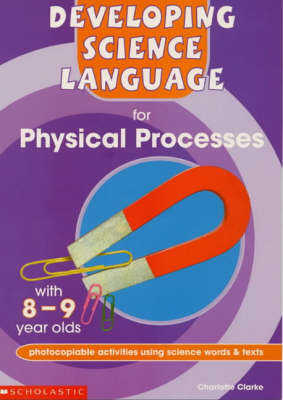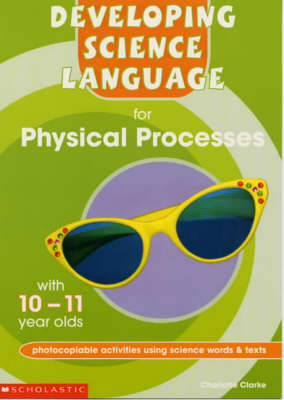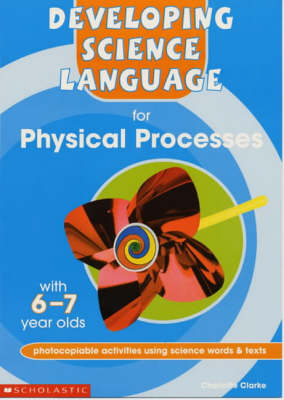Developing Science Language
3 total works
Science teaching in England is increasingly driven by the KS2 SATs, where the children are required to know key facts and words and be able to interpret experimental data presented as a table or graph. The children need to be able to use specific scientific language-rambling descriptions do not get marks! Also, teachers areseeking to integrate aspects of science. literacy and maths as timetabling is made increasingly difficult due to the demands of the NLS and NNS. Each fully photocopiable book in the DEVELOPING SCIENCE LANGUAGE series will be split into around ten 6-8 page 'units', each hitting a significant science curriculam topic. Content will include aspects of all the UK curricula with refernces indicating which topics occur in which documentation.
Each unit will comprise of:- apiece of non-fiction/information text pitched to the younger reading age prescribed (ie 6/8/10 year olds), with key vocabulary highlighted - two comprehension activities based on the text (broadly equivalent to one activity differentiated by the two age groups) -optionally, one or more language-based or 'visual' activities using or accessing the text or related knowledge 'DSL: PHYSICAL PROCESSES 8-9' will address the 'physics' topics covered by the UK curricula at KS2/P4-7, using the QCA 'Science Scheme of Work' units for Y3 and Y4 as a more detailed guide. To this will be added appropriate content from the other UK science curriculam documents, in particular the new Scottish 5-14 guidelines on Environmental Studies. 'DSL: PHYSICAL PROCESSES 8-9' units will include 'Friction' and 'Shadows through the day', for example.; Photocopiable science information texts appropriate to target age group.; Differentiated comprehensions-credible literacy.; Fully-photocopiable activities to develop science literacy: comprehension tasks and word games.; Highlights and teaches key science vocabulary in context.;
Essential support for KS1 and 2 science assessments and Y6 SATs
Each unit will comprise of:- apiece of non-fiction/information text pitched to the younger reading age prescribed (ie 6/8/10 year olds), with key vocabulary highlighted - two comprehension activities based on the text (broadly equivalent to one activity differentiated by the two age groups) -optionally, one or more language-based or 'visual' activities using or accessing the text or related knowledge 'DSL: PHYSICAL PROCESSES 8-9' will address the 'physics' topics covered by the UK curricula at KS2/P4-7, using the QCA 'Science Scheme of Work' units for Y3 and Y4 as a more detailed guide. To this will be added appropriate content from the other UK science curriculam documents, in particular the new Scottish 5-14 guidelines on Environmental Studies. 'DSL: PHYSICAL PROCESSES 8-9' units will include 'Friction' and 'Shadows through the day', for example.; Photocopiable science information texts appropriate to target age group.; Differentiated comprehensions-credible literacy.; Fully-photocopiable activities to develop science literacy: comprehension tasks and word games.; Highlights and teaches key science vocabulary in context.;
Essential support for KS1 and 2 science assessments and Y6 SATs
Science teaching in England is increasingly driven by the KS2 SATs, where the children are required to know key facts and words and be able to interpret experimental data presented as a table or graph. The children need to be able to use specific scientific language-rambling descriptions do not get marks! Also, teachers are seeking to integrate aspects of science, literacy and maths as timetabling is made increasingly difficult due to the demands of the NLS and NNS. Each fully photocopiable book in the DEVELOPING SCIENCE LANGUAGE series will be split into around ten 6-8 page 'units', each hitting a significant science curriculum topic. Content will include aspects of all the UK curricula, with references indicating which topics occur in which documentation.
Each unit will comprise of: a piece of non-fiction/information text pitched to the younger reading age prescribed (ie 6/8/10 year olds), with key vocabulary highlighted-two comprehension activities based on the text (broadly equivalent to one activity differentiated by the two age groups) - optionally, one or more language-based or 'Visual' activities using or accessing the text or related knowledge'DSL: PHYSICAL PROCESSES 10-11' will address the 'physics' topics covered by theUK curricula at KS2/P4-7, using the QCA 'Science Scheme of Work' units for Y5 and Y6 as a more detailed guide. To this will be added appropriate content from the other UK science curriculum documments, in particular the new Scottish 5-14 guidelines on Environmental Studies. 'DSL:PHYSICAL PROCESSES 10-11' units will include 'changing circuits', Gravity and air resistance' or 'Reflection and seeing', for example.; Photocopiable science information texts appropriate to target age group.; Differentiated comprehensions-credible literacy.; Fully-photocopiable activities to develop science literacy: comprehension tasks and word games.; Highlights and teaches key science vocabulary in context.
Each unit will comprise of: a piece of non-fiction/information text pitched to the younger reading age prescribed (ie 6/8/10 year olds), with key vocabulary highlighted-two comprehension activities based on the text (broadly equivalent to one activity differentiated by the two age groups) - optionally, one or more language-based or 'Visual' activities using or accessing the text or related knowledge'DSL: PHYSICAL PROCESSES 10-11' will address the 'physics' topics covered by theUK curricula at KS2/P4-7, using the QCA 'Science Scheme of Work' units for Y5 and Y6 as a more detailed guide. To this will be added appropriate content from the other UK science curriculum documments, in particular the new Scottish 5-14 guidelines on Environmental Studies. 'DSL:PHYSICAL PROCESSES 10-11' units will include 'changing circuits', Gravity and air resistance' or 'Reflection and seeing', for example.; Photocopiable science information texts appropriate to target age group.; Differentiated comprehensions-credible literacy.; Fully-photocopiable activities to develop science literacy: comprehension tasks and word games.; Highlights and teaches key science vocabulary in context.
Science teaching in England is increasingly driven by the KS2 SATs, where the children are required to know key facts and words and be able to interpert experimental data presented as a table or graph. The dhildren need to be abpe to use specific scientific language - rambling descriptions do not get marks! Also teachers are seeking to integrate aspects of science, literacy and maths as timetabling is made increasingly difficult due to the demands of the NLS and NNS. Each fully photocopiable book in the DEVELOPING SCIENCE LANGUAGE series will be split into around ten 6-8 page 'units' each hitting a significant science curriculum topic. Content will include aspects of all the UK curricula, with references indicating which topics occur in which documentation.
Each unit will comprise of: -a price of non-fiction/information text pitched to the younger reading age prescribed (ie 6/8/10 year olds), with key vocabulary highlighted-two comprehension activities based on the text (broadly equivalent to one activity differentiated by the two age groups) - optionally, one or more language-based or 'visual' activities using or accessing the text or related knowledge 'DSL:PHYSICAL PROCESSES 6-7' will include: the 'physics' topics covered by the UK curricula at KS1/P1-3, using the QCA 'Science Scheme of Work' units for Y1 and Y2 as more detailed guide. To this will be added appropriate content from the other UK science documents, in particular the new Scottish 5-14 guidelines on Environmental Studies. 'DSL:PHYSICAL PROCESSES 6-7' units will include 'Using and misusing electricity' 'Pushes and pulls' or 'Day and night' for example.; Photocopiable science information texts appropriate to target age group.; Differentiated comprehensions-credible literacy.; Fully-photocopiable activities to develop science literacy: comprehension tasks and word games.; Highlights and teaches key science vocabulary in context.
Each unit will comprise of: -a price of non-fiction/information text pitched to the younger reading age prescribed (ie 6/8/10 year olds), with key vocabulary highlighted-two comprehension activities based on the text (broadly equivalent to one activity differentiated by the two age groups) - optionally, one or more language-based or 'visual' activities using or accessing the text or related knowledge 'DSL:PHYSICAL PROCESSES 6-7' will include: the 'physics' topics covered by the UK curricula at KS1/P1-3, using the QCA 'Science Scheme of Work' units for Y1 and Y2 as more detailed guide. To this will be added appropriate content from the other UK science documents, in particular the new Scottish 5-14 guidelines on Environmental Studies. 'DSL:PHYSICAL PROCESSES 6-7' units will include 'Using and misusing electricity' 'Pushes and pulls' or 'Day and night' for example.; Photocopiable science information texts appropriate to target age group.; Differentiated comprehensions-credible literacy.; Fully-photocopiable activities to develop science literacy: comprehension tasks and word games.; Highlights and teaches key science vocabulary in context.


